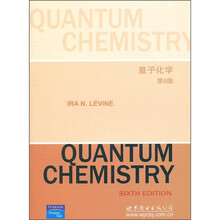量子化学(第6版)

目 录内容简介
PREFACE
1 THE SCHRODINGER EQUATION
1.1 Quantum Chemistry
1.2 Historical Background of Quantum Mechanics
1.3 The Uncertainty Principle
1.4 The Time-Dependent Schrodinger Equation
1.5 The Time-Independent Schrodinger Equation
1.6 Probability
1.7 Complex Numbers
1.8 Units
1.9 Calculus
1.10 Summary
2 THE PARTICLE IN A BOX
2.1 Differential Equations
2.2 Particle in a One-Dimensional Box
2.3 The Free Particle in One Dimension
2.4 Particle in a Rectangular Well
2.5 Tunneling
2.6 Summary
3 OPERATORS
3.1 Operators
3.2 Eigenfunctions and Eigenvalues
3.3 Operators and Quantum Mechanics
3.4 The Three-Dimensional, Many-Particle Schrodinger Equation
3.5 The Particle in a Three-Dimensional Box
3.6 Degeneracy
3.7 Average Values
3.8 Requirements for an Acceptable Wave Function
3.9 Summary
4 THE HARMONIC OSCILLATOR
4.1 Power-Series Solution of Differential Equations
4.2 The One-Dimensional Harmonic Oscillator
4.3 Vibration of Molecules
4.4 Numerical Solution of the One-Dimensional Time-Independent Schrodinger Equation
4.5 Summary
5 ANGULAR MOMENTUM
5.1 Simultaneous Specification of Several Properties
5.2 Vectors
5.3 Angular Momentum of a One-Particle System
5.4 The Ladder-Operator Method for Angular Momentum
5.5 Summary
6 THE HYDROGEN ATOM
6.1 The One-Particle Central-Force Problem
6.2 Noninteracting Particles and Separation of Variables
6.3 Reduction of the Two-Particle Problem to Two One-Particle Problems
6.4 The Two-Particle Rigid Rotor
6.5 The Hydrogen Atom
6.6 The Bound-State Hydrogen-Atom Wave Functions
6.7 Hydrogenlike Orbitals
6.8 The Zeeman Effect
6.9 Numerical Solution of the Radial Schr6dinger Equation
6.10 Summary
7 THEOREMS OF QUANTUM MECHANICS
7.1 Introduction
7.2 Hermitian Operators
7.3 Expansion in Terms of Eigenfunctions
7.4 Eigenfunctions of Commuting Operators
7.5 Parity
7.6 Measurement and the Superposition of States
7.7 Position Eigenfunctions
7.8 The Postulates of Quantum Mechanics
7.9 Measurement and the Interpretation of Quantum Mechanics
7.10 Matrices
7.11 Summary
8 THE VARIATION METHOD
8.1 The Variation Theorem
8.2 Extension of the Variation Method
8.3 Determinants
8.4 Simultaneous Linear Equations
8.5 Linear Variation Functions
8.6 Matrices, Eigenvalues, and Eigenvectors,
8.7 Summary
9 PERTURBATION THEORY
10 ELECTRON SPIN AND THE SPIN-STATISTICS THEOREM
11 MANY-ELECTRON ATOMS
12 MOLECULAR SYMMETRY
13 ELECTRONIC STRUCTURE OF DIATOMIC MOLECULES
14 THEOREMS OF MOLECULAR QUANTUM MECHANICS
15 MOLECULAR ELECTRONIC STRUCTURE
16 ELECTRON-CORRELATION METHODS
17 SEMIEMPIRICAL AND MOLECULAR-MECHANICS TREATMENTS
OF MOLECULES 636
18 COMPARISONS OF METHODS
APPENDIX
BIBLIOGRAPHY
ANSWERS TO SELECTED PROBLEMS
INDEX
1 THE SCHRODINGER EQUATION
1.1 Quantum Chemistry
1.2 Historical Background of Quantum Mechanics
1.3 The Uncertainty Principle
1.4 The Time-Dependent Schrodinger Equation
1.5 The Time-Independent Schrodinger Equation
1.6 Probability
1.7 Complex Numbers
1.8 Units
1.9 Calculus
1.10 Summary
2 THE PARTICLE IN A BOX
2.1 Differential Equations
2.2 Particle in a One-Dimensional Box
2.3 The Free Particle in One Dimension
2.4 Particle in a Rectangular Well
2.5 Tunneling
2.6 Summary
3 OPERATORS
3.1 Operators
3.2 Eigenfunctions and Eigenvalues
3.3 Operators and Quantum Mechanics
3.4 The Three-Dimensional, Many-Particle Schrodinger Equation
3.5 The Particle in a Three-Dimensional Box
3.6 Degeneracy
3.7 Average Values
3.8 Requirements for an Acceptable Wave Function
3.9 Summary
4 THE HARMONIC OSCILLATOR
4.1 Power-Series Solution of Differential Equations
4.2 The One-Dimensional Harmonic Oscillator
4.3 Vibration of Molecules
4.4 Numerical Solution of the One-Dimensional Time-Independent Schrodinger Equation
4.5 Summary
5 ANGULAR MOMENTUM
5.1 Simultaneous Specification of Several Properties
5.2 Vectors
5.3 Angular Momentum of a One-Particle System
5.4 The Ladder-Operator Method for Angular Momentum
5.5 Summary
6 THE HYDROGEN ATOM
6.1 The One-Particle Central-Force Problem
6.2 Noninteracting Particles and Separation of Variables
6.3 Reduction of the Two-Particle Problem to Two One-Particle Problems
6.4 The Two-Particle Rigid Rotor
6.5 The Hydrogen Atom
6.6 The Bound-State Hydrogen-Atom Wave Functions
6.7 Hydrogenlike Orbitals
6.8 The Zeeman Effect
6.9 Numerical Solution of the Radial Schr6dinger Equation
6.10 Summary
7 THEOREMS OF QUANTUM MECHANICS
7.1 Introduction
7.2 Hermitian Operators
7.3 Expansion in Terms of Eigenfunctions
7.4 Eigenfunctions of Commuting Operators
7.5 Parity
7.6 Measurement and the Superposition of States
7.7 Position Eigenfunctions
7.8 The Postulates of Quantum Mechanics
7.9 Measurement and the Interpretation of Quantum Mechanics
7.10 Matrices
7.11 Summary
8 THE VARIATION METHOD
8.1 The Variation Theorem
8.2 Extension of the Variation Method
8.3 Determinants
8.4 Simultaneous Linear Equations
8.5 Linear Variation Functions
8.6 Matrices, Eigenvalues, and Eigenvectors,
8.7 Summary
9 PERTURBATION THEORY
10 ELECTRON SPIN AND THE SPIN-STATISTICS THEOREM
11 MANY-ELECTRON ATOMS
12 MOLECULAR SYMMETRY
13 ELECTRONIC STRUCTURE OF DIATOMIC MOLECULES
14 THEOREMS OF MOLECULAR QUANTUM MECHANICS
15 MOLECULAR ELECTRONIC STRUCTURE
16 ELECTRON-CORRELATION METHODS
17 SEMIEMPIRICAL AND MOLECULAR-MECHANICS TREATMENTS
OF MOLECULES 636
18 COMPARISONS OF METHODS
APPENDIX
BIBLIOGRAPHY
ANSWERS TO SELECTED PROBLEMS
INDEX
目 录内容简介
《量子化学(第6版)》共18章,总共750多页,内容非常丰富。书中把量子力学的基本原理,各个不同体系中薛定谔方程及其近似解法,尤其针对化学特有的分子体系的量子力学理论与电子结构计算方法(从头算、密度函数、半经验、分子力学、价键理论)进行了详细介绍,并针对上述方法在计算基态分子性质的性能方面进行了十分详细的对比分析,对实际应用有很好的参考价值。
比价列表
公众号、微信群
 缺书网
缺书网微信公众号
 扫码进群
扫码进群实时获取购书优惠





